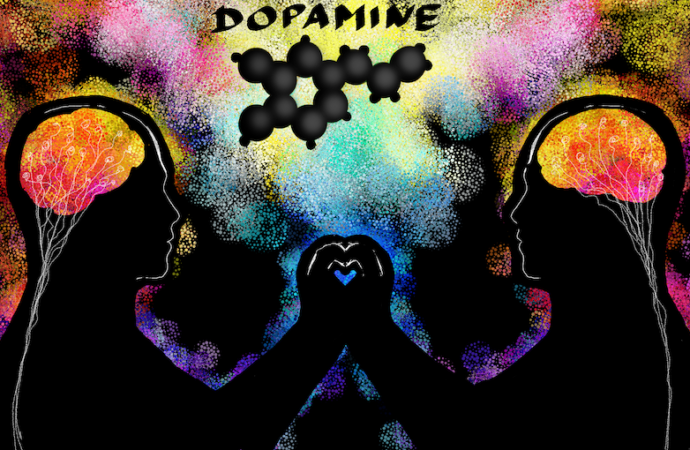The brain is the master of human sexual behavior. It plays an important role in sexual desire, arousal, and orgasm. Sex is a complex process, which involves many neural networks. What chemicals are involved in capturing the pleasure of sex? What makes us stubbornly pursue it? Let’s explore what having sex looks like from our brain’s perspective and the chemicals involved.
Why do we feel pleasure while touching and sex? The answer is dopamine. This neurotransmitter is responsible for the feeling of joy before, during, and after intimate contact. Neurotransmitters are chemicals responsible for information transmission in the brain.
Dopamine is produced in the brain in the hypothalamus by specialized neurons called dopamine neurons. The effect of dopamine on the body depends on what kind of neurons perceive it from the dopamine neurons. If dopamine neurons are destroyed, Parkinson’s disease symptoms and other neurodegenerative disorders may be observed.
Dopamine is one of the most explored neurotransmitters involved in the control of human sexual behavior. It is strongly connected with feelings; it drives motivation and reward. In men, dopamine is responsible for erection and ejaculation. Without proper dopamine levels, these processes cannot proceed properly. When given as a drug, dopamine could reduce and even heal low sexual desire in women. But it cannot cure sexual dysfunction.
Why do we lose control during sex?
Sexual intercourse can cause a roller-coaster in your brain. While the brain is the control unit of human sexual behavior, it may get lost during lovemaking, and the logical part is silenced. An increase in blood flow is triggered by a surge in nitric oxide (gas widening blood vessels). Dopamine and adrenaline levels rise throughout the body.
As you approach the climax, your muscles begin to tighten. An orgasm puts the brain into a trance-like state. Certain areas related to pain, emotions, and the rewording system are activated in our brain during the climax.
Distant parts of the brain, in men and women, are involved in the orgasm process. In males, foreplay activated the right amygdala, inducing penile erection, sexual feelings, and pleasure. In females, during the climax, active brain areas are responsible for emotions, pain, and regulation of specific metabolic processes and decision-making.
The optimal level of dopamine
The right dopamine level is beneficial for the human organism. It regulates the sleep process. If a person sleeps well, is refreshed, has more energy, which may increase the sex drive.
Sex activity benefits our immune system. A person who has intercourse twice a week can have a higher immunoglobulin A level, the substance responsible for immunity. At an older age, having sex frequently may contribute to the improvement of memory. But it can also provide rare cases of transient global amnesia, which is a temporary episode of memory loss. Studies show that people who have a successful sex life in later life are less likely to develop high blood pressure. Sex also boosts confidence and creativity.
Do aphrodisiacs work?
The optimal libido level is a sign of health and vitality. This is where the right diet can help. Foods called aphrodisiacs can be of considerable assistance to raise the libido. The most famous aphrodisiac is oysters. This food supplies minerals like zinc that are essential for the production of testosterone and dopamine.
Caviar is also an aphrodisiac rich in vitamins such as A, E, B6, and nutrients such as iron, magnesium, selenium, and omega-3 acids. It supports the immune, circulatory, and nervous systems; and, in men, stimulates testosterone production. Caviar contains the amino acid l-arginine, which has a vasodilating effect, increasing blood flow and translating into properly functioning sex organs.
Not only animal-origin foods increase libido, but also vegetables and fruits. For example, the popular avocado provides vitamin E, potassium, and vitamin B6. It is a good source of monounsaturated fats, which are also found in nuts, olives, and seeds. These fats promote healthy heart and blood circulation.
Another one is maca, the so-called Peruvian Viagra, the sweet root known as coffee spice. If we’re talking about herbs, another aphrodisiac is cayenne pepper. It contains Capsaicin, which causes blood vessels to widen, lowering blood pressure. The rich blood flow in the tissues improves sexual function. Capsaicin can also increase testosterone levels in men and thus libido.
Cocoa is another aphrodisiac that provides many benefits to our body, like stress reduction. It improves brain function, which positively affects the level of our libido. Cocoa contains a substance called phenylethylamine, which helps release serotonin, one of the happiness neurotransmitters; it produces, for example, falling in love. In women, the level of libido increases after consuming cocoa. Dark chocolate contains about 70% of cocoa.
Many other ways can be used to stimulate the dopamine release in the brain. Some theories say that meditation can increase its level, but that is a story for another time.
Dopamine is an essential substance for the entire body triggering multiple reactions like feelings of passion. It produces addiction that brings us satisfaction. It also plays a vital role in physical activities like sport and sex, positively influencing our brains and bodies. Dopamine can also reduce our stress and anxiety. A good level of Dopamine can be stimulated by the proper diet and the use of aphrodisiacs. However, everything should be done in moderation so as not to become addicted.
This article is a joint work of Agnieszka Pregowska (Institute of Fundamental Technological Research, Polish Academy of Sciences) and Magdalena Osial (Faculty of Chemistry, University of Warsaw). Images Credit: Magdalena Osial.
References
[1] Balestrino, R., Schapira, A.H.V. (2019) Parkinson disease. European Journal of Neurology. 27(1), 27-42. https//doi.org/10.1111/ene.14108
[2] Giuliano, F. (2011) Neurophysiology of erection and ejaculation. The Journal of Sexual Medicine. 4, 310-5. https//doi.org/10.1111/j.1743-6109.2011.02450.x
[3] Fourcroy, J.L. (2003) Female sexual dysfunction: potential for pharmacotherapy. Drugs. 63(14), 1445-57. https//doi.org/10.2165/00003495-200363140-00002
[4] Luders, E., Toga, A. W. (2010) Chapter 1 – Sex differences in brain anatomy, Progress in Brain Research. 186, 2-12. https//doi.org/10.1016/B978-0-444-53630-3.00001-4
[5] Ruesink, G.B., Georgiadis, J.R. (2017) Brain Imaging of Human Sexual Response: Recent Developments and Future Directions. Current Sexual Health Reports. 9(4), 183-191. https//doi.org/10.1007/s11930-017-0123-4
[6] Georgiadis, J.R., Holstege G. (2005) Human brain activation during sexual stimulation of the penis. Journal of Comparative Neurology. 493(1), 33-8.https//doi.org/10.1002/cne.20735
[7] Wise, N.J., Frangos, E, Komisaruk, B.R. (2017) Brain Activity Unique to Orgasm in Women: An fMRI Analysis. The Journal of Sexual Medicine. 14(11), 1380-1391. https//doi.org/10.1016/j.jsxm.2017.08.014
[8] Charnetski, C.J., Brennan, F.X. (2004) Sexual frequency and salivary immunoglobulin A (IgA). Psychological Reports. 94(3 Pt 1), 839-44. https//doi.org/10.2466/pr0.94.3.839-844.
[9] Allen, M.S. (2018) Sexual Activity and Cognitive Decline in Older Adults. Archives of Sexual Behavior. 47, 1711-1719. https//doi.org/10.1007/s10508-018-1193-8
[10] Gallagher, J., Murphy, M.S., Carroll, J. (2005) Transient global amnesia after sexual intercourse. Irish Journal of Medical Sciences. 174(3), 86-7. https//doi.org/10.1007/BF03169155.
[11] Liu, H., Waite, L.J., Shen, S., Wang, D.H. (2016) Is Sex Good for Your Health? A National Study on Partnered Sexuality and Cardiovascular Risk among Older Men and Women. Journal of Health and Social Behavior. 57(3), 276-96. https//doi.org/10.1177/0022146516661597
[12] Kourkouta, L., Ouzounakis, P., Papathanassiou, I., Koukourikos, K., Tsaras, K., Iliadis, C., Monios, A., Tsaloglidou, A. (2017) Sleep and Health: Role of Dopamine. https//doi.org/10.5772/intechopen.79476
[13] West, E., Krychman, M. (2015) Natural Aphrodisiacs-A Review of Selected Sexual Enhancers. Sexual Medicine Reviews. 3(4), 279-288. https//doi.org/10.1002/smrj.62
[14] Shin, B.C., Lee, M.S., Yang, E.J., Hyun-Suk, L., Edzard, E. (2010) Maca (L. meyenii) for improving sexual function: a systematic review. BMC Complementary and Alternative Medicine. 10, 44. https//doi.org/10.1186/1472-6882-10-44
[15] Salonia, A., Fabbri, F., Zanni, G., Scavini, M., Fantini, G.V., Briganti, A., Naspro, R., Parazzini, F., Gori, E., Rigatti, P., Montorsi, F. (2006). Chocolate and women’s sexual health: An intriguing correlation. Journal of Sexual Medicine, 3(3), 476-482. https//doi.org/10.1111/j.1743-6109.2006.00236.x





